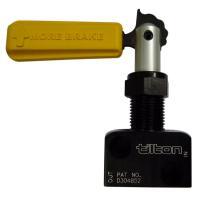I doubt very much that the ABS programming will vary based on calliper, rotor and/or piston sizing. It just relies on the wheel's ABS sensor to detect lock up and then bypasses the brake pedal pressure until the wheel starts to rotate again, then pulses the bypassing to achieve the ~20% locked to unlocked ratio. What size the calliper, rotor and/or piston/s are is irrelevant.
Larger pistons require more brake pedal movement for the same braking force, probably best avoided if you are dealing with a long pedal. Smaller piston area would be better for that.
There is also what I call the "hydraulic ratio" to be considered, for the same amount of pedal pressure exerted a larger piston will produce less braking effect, due to lower pressure acting on the pad. Another reason to avid larger diameter pistons if you are trying to alleviate a long pedal as you will have to push harder to achieve the same braking effect.
What is relevant is the leverage ratio of a larger diameter rotor, obviously the larger diameter a rotor is the more braking effect it will have for the same pedal travel and pedal pressure.
Also worth keeping in mind that a larger pad area increases the friction, hence provides more braking effect given equal pad material. Has no real effect on pedal travel, but may result is less pedal effort for the same braking effect.
As I have posted previously, the more I read of peoples' experiences the more I am inclined to be suspicious of leakage in the ABS bypass, or at the very least premature bypassing, being the cause of the long pedal. Is it possible that the bypassing can be related to the software programming of the ABSCU, which could be fixed by a few keystrokes in the appropriate places? Master cylinder, rotor and calliper swaps, different pad material, braided brake lines, firewall stiffeners etc etc have had negligible effect. What's left, the ABS unit?
Cheers
Gary
Larger pistons require more brake pedal movement for the same braking force, probably best avoided if you are dealing with a long pedal. Smaller piston area would be better for that.
There is also what I call the "hydraulic ratio" to be considered, for the same amount of pedal pressure exerted a larger piston will produce less braking effect, due to lower pressure acting on the pad. Another reason to avid larger diameter pistons if you are trying to alleviate a long pedal as you will have to push harder to achieve the same braking effect.
What is relevant is the leverage ratio of a larger diameter rotor, obviously the larger diameter a rotor is the more braking effect it will have for the same pedal travel and pedal pressure.
Also worth keeping in mind that a larger pad area increases the friction, hence provides more braking effect given equal pad material. Has no real effect on pedal travel, but may result is less pedal effort for the same braking effect.
As I have posted previously, the more I read of peoples' experiences the more I am inclined to be suspicious of leakage in the ABS bypass, or at the very least premature bypassing, being the cause of the long pedal. Is it possible that the bypassing can be related to the software programming of the ABSCU, which could be fixed by a few keystrokes in the appropriate places? Master cylinder, rotor and calliper swaps, different pad material, braided brake lines, firewall stiffeners etc etc have had negligible effect. What's left, the ABS unit?
Cheers
Gary



Comment